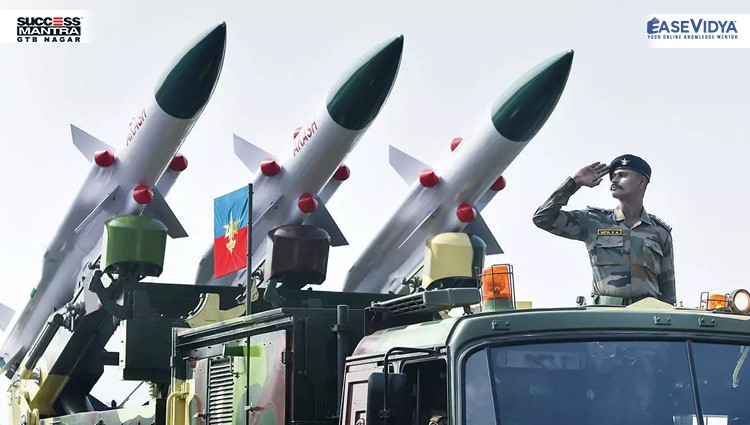
SELF RELIANT DEFENCE
SELF-RELIANT DEFENCE
Introduction:
The Ministry of Defence has been allocated a total budget of Rs 5.25 lakh crore for Financial Year 2022-23 with a focus on modernisation of Defence Services and Defence Security Infrastructure development including the Border Road Infrastructure and Coastal Security Infrastructure. The total allocation under Capital Outlay of the Defence Services has been increased from Rs 86,740 crore in 2013-14 to 1.52 lakh crore in 2022-23. 68 per cent of the capital procurement budget will be earmarked for domestic industry in 2022-23, up from 58 per cent in the previous year indicating Government’s commitment to reducing imports and promoting Atma Nirbhar bharat.While Defence R&D will be opened up for industry, startups and academia, Private industry will also be encouraged to take up design and development of military platforms and equipment in collaboration with DRDO and other organisations through the SPV model.
Need for defence indigenization:
- For self reliance
- To conserve or reduce Balance of Payment deficit
- To promote employment and also exports
- To reduce cost of production to India and thereby reduce fiscal deficit. According to the Stockholm International Peace Research Institute (SIPRI), in 2019, India became the third-largest defence spender in the world
Need for framework to achieve self-reliance:
- The IPR has emerged as a key ingredient of an ecosystem which stimulates innovation and ingenuity.
- Our knowledge and creativity have often not been utilised to its full potential due to lack of awareness on modern legal framework for protection of IP rights so it is need of the time to be aware about IPR (Intellectual Property Rights).
- India has accumulated several technologies gained through Transfer of technology (ToT) agreements but for any design adjustments in the platforms, the original manufacturer has to be consulted.
- Further, it helps in safeguarding national security secrets.
- India is the second largest arms importer in the world. It helps reduce the national spending on imports of arms and defence technology.
- It would also help earn some forex by selling the indigenously designed and developed defence equipment.
- India’s aim to generate 2-3 million additional jobs in the manufacturing industry and a boost to MSMEs can be achieved.
Measures needed:
- To boost indigenization, DRDO needs to be given more autonomy like space and atomic energy departments
- Setting up of the planned defence industrial corridors.
- Robust Defence Diplomacy, for which a cadre of defence diplomats should be created so that new coordination with the world can bring new ideas and innovations.
- Setting up of a Defence Export Organisation to promote export of defence equipment.
- Instituting an Independent Audit addressing issues of inefficiency and accountability, this shall help in keeping the flow of ideas and innovation.
- Setting up an aerospace university, can help in bringing new ideas and innovations
Challenges
- Lack of Defence Manufacturing base in India
- Primarily driven by Government ordnance factories and poor private participation
- The public sector (DPSUs/OFs) by far has enjoyed the preferred categorization, particularly for big ticket purchases, when considering the Indian route, despite its poor track record as regards time and cost overruns, inefficiencies and poor financial performance.
- The defence industry per-se being a capital intensive industry with high risks on investments leaves very few private players in the arena. DPSUs, on the other hand, have not done much to promote proficient business practices by involving the industry and Micro, Small,and Medium Enterprises (MSMEs).
- The report of the 33rd StandingCommittee on Defence – Indigenization of Defence Production: PublicPrivate Partnership was highly critical of the steps taken by the government to promote indigenization
- High costs and involved and lack of assured market
- Poor technological transfer by foreign companies
- Lack of Data
- Bureaucratic delay and licensing issues:there is still no eas of doing business in defence industry.: Investment in the defence sector is subject to compliance with the licensing requirements stipulated by the Department of Industrial Policy and Promotion (DIPP)
Way Forward:
- Defence offset policies need better monitoring, removing unnecessary restrictions and linking defence offsets with offset in the civil sector. That should be encouraged.
- To boost indigenization, the Defence Research & Development Organisation (DRDO) needs to be given more autonomy like space and atomic energy departments.
- Even a playing field should be created between the Defence Public Sector Undertakings (DPSUs) and the private sector companies.
- Indian defence PSUs and ordnance factories have a lot of potential, they need to be “revived, revitalised and made a lot more dynamic”.
- Establishing courses on defence production across universities and creating job opportunities for the graduates.
- The government needs to expedite the setting up of a professional defence procurement agency.
- Meeting the objectives of defence exports, encouraging innovation, streaming lining procurements will require robust defence diplomacy. A cadre of defence diplomats should be created to address these issues.
- The country needs an elaborate ecosystem of innovation of which defence innovation can be a part.
Conclusion:
Self-reliance is a major corner-stone on which the military capability of any nation rests. Indigenous defence production is an essential capability to provide strategic independence to a nation, thus making exponential additions to national security through round-the-clock defence preparedness.













0 Comment